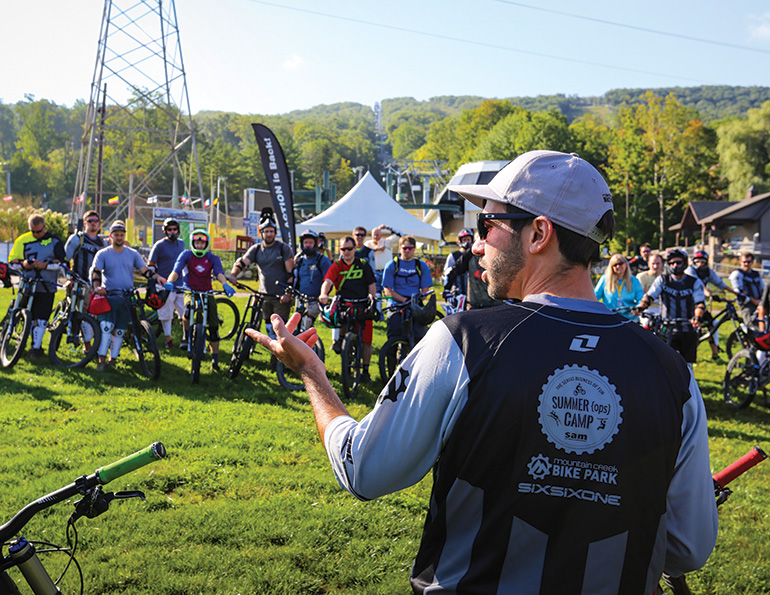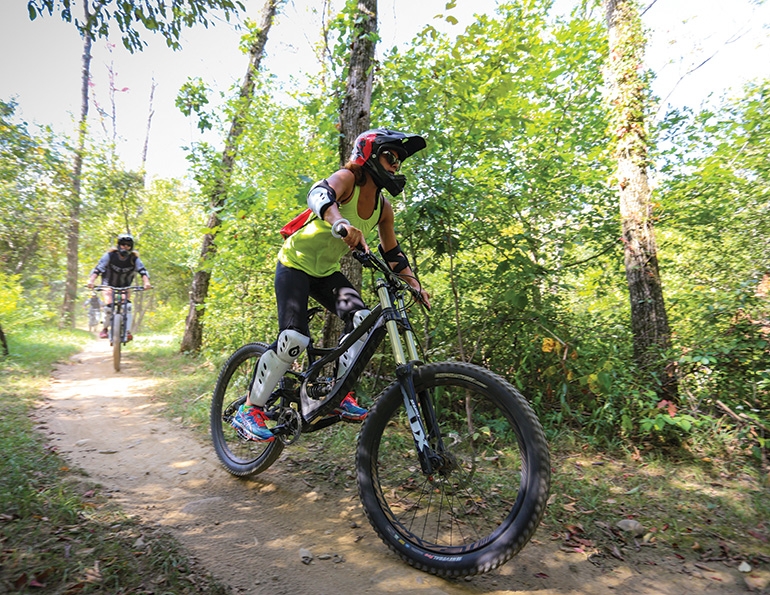Mountain resorts offer the ideal environment for a downhill mountain bike park. Still, a successful park doesn’t spring up overnight. There are several considerations and steps resorts can take to either start a program or adapt an existing program.
A bike park should appeal to riders of all abilities, not just the rugged and experienced. A balanced offering of trail variety and skill level progression helps to convert and retain customers. But that balance must be promoted and marketed well. For many years the primary terrain available was gnarly single track, and as a result, the idea of downhill mountain biking can be intimidating.
Having a variety of modern, machine-built trails and a comprehensive learn-to program are key building blocks for a successful bike park. When done right, a park will generate recurring revenue and return customers, leading to sustainable, financial success.
Here are 10 elements to a profitable bike park:
1. Paint the right picture
Why hasn’t downhill mountain biking already taken off? The problem lies in the perception people have of downhilling as a bone-breaking activity suited only for crazy people. This image stems from the ’80s and ’90s, when trails were built down the fall line over rough and steep terrain.
More operators are now building and marketing bike parks designed to accommodate all abilities, so that outdated perception is fading.
To reinforce the inclusive nature of the modern bike park, be consistent with the images used in your marketing. The picture you paint should be representative of the guest experience. Shoot videos and photos of families taking lessons and riding beginner terrain, then post that content on all media outlets. Display these same friendly images on-site in the shop and any other high traffic areas. If you deliver on this imagery, the result will be a customer who leaves the park with a smile and a desire to return. You will also create an ambassador for your bike park and the sport.
Then the test will be your ability to retain that customer and convert him or her into a seasoned regular to your bike park.
2. Build trails fortoday’s rider
This is a recurring theme: Your bike park should be inclusive, with terrain for all abilities. Level of difficulty is one aspect to that, but even more important is trail type. There are two main types: organic and freeride.
Organic bike trails—natural trails, likely built by hand, without jumps or other unnaturally occurring elements—have been around since the beginning. Their roots, rocks, bumps, and drops require technical riding skills.
Conversely, a freeride trail is typically built by machine and is the foundation of modern bike parks. It’s usually wider, smoother, and offers more flow than an organic trail. These characteristics are less intimidating and help the novice rider progress at a comfortable pace.
Every bike park, new or existing, should have at least three freeride trails, plus a designated skills development area, all with enough variation to cater to every level of rider.
The most important trail of all? A beginner freeride trail. It should be wide and smooth with small rollers, jumps, and other basic obstacles, and have a mellow pitch of five degrees or less. A trail like this will entice families, kids, schools, scout groups—basically, the entire bike-riding population. Beginner freeride trails are the catalyst for major growth in bike parks for years to come.
This is not to say a resort should ignore or forego organic trails. A mix of organic and freeride trails will keep driving people back to your park. But organic trails are not the means for getting first-timers hooked on bike parks.
3. Build a variety of trails
Our most popular trail at Highland, called Cat’s Paw, appeals to the widest skill range of our customers. The base structure is a more difficult (blue square) freeride trail. Features on Cat’s Paw are designed and located so advanced riders have the option to go big, intermediate riders can experiment with getting some air, and novice riders can keep their tires on the ground the whole way. The jumps and drops can be hit at speed, or completely avoided. Many of them are wooden features; others are built with dirt.
To suit a wide range of abilities, trails should have alternate routes around difficult features, and include tabletop jumps so that a rider can simply ride over the feature or come up short without disastrous consequences. With the right design and build, one trail can be fun for all abilities.
Novice riders will return if trails are built to offer progression from one level to the next and there’s trail variety to choose from. Design the bike park to be accessible to all, and the perception will change from fear to fun.
4. Offer “learn to ride” Lesson packages
Make it easy for first timers by offering a lesson package deal with a bike, protective equipment, day pass, and lesson at a discounted price. Your coaches should be personable, talented, and well trained.
To break down the fear barrier, start all new riders in a skills development area at the base of the mountain. This area should include flat surfaces, mellow pitches, and freeride features like rollers and banked turns. Coaches can assess riders and provide feedback on their technique and tips for improvement during each pass. Once the coaches determine the riders are ready, the next step is a lift ride up to the easiest freeride trail.
Make it mandatory for the customer to take the lesson in order to receive the package deal. The deal itself will entice newcomers to visit your bike park, while the lesson will impart proper riding technique and reduce the potential for injury.
5. Mitigate risk with good trail signage
The trail rating system should be consistent throughout the park, not only for level of difficulty, but also to identify organic terrain versus freeride. A black diamond organic trail will ride differently than a black diamond freeride trail, and even experienced riders are more proficient at one or the other. This co-identification of organic or freeride should apply to all levels of difficulty.
When it comes to the symbols and colors you use, the ski industry already has a trail rating system that’s familiar to the general public. Consistency in these key identifiers from the ski area to the bike park will help keep riders on the trails that are right for them.
Even so, make sure guests are aware of how your park designates trail types and levels of difficulty before they get on the mountain. Clearly communicate this in your marketing materials, displays in the shop, on your website, and at lift access points.
6. Staff a “bike patrol”
Like skiing and snowboarding, downhill mountain biking is an inherently risky sport. It’s inevitable that people will get injured, so staffing and equipping an on-hill bike patrol is key.
When a person is injured, the level of care provided by the resort is a reflection of how much the resort cares about its customer and grasps its bike park business. Hire an adequate number of staff, train them properly, and design the trails so that you can quickly extract and transport an injured rider to medical attention. In parks that are understaffed or lack emergency access, it can take more than an hour to extract an injured rider.
The patrol department is an expense item, but without it you run the risk of losing customers and revenue—or worse.

7. Good trail maintenance leads to happy guests
What level of maintenance is needed to create a good ride? Fair question. Trail maintenance depends on a number of factors: trail type (freeride or organic), soil conditions, rider volume, weather, rider preference, sustainability, and erosion.
Bike park customers will tolerate varying degrees of trail conditions; this is not a freeway, after all. Still, freeride trails—specifically blue squares and black diamonds—see the most traffic and require regular maintenance. Most customers expect a freeride trail to be relatively smooth from top to bottom. The more haggard a trail gets, the more customers will complain. Operators should pay special attention to customer feedback and do the best they can to limit degradation of trail conditions.
Typically, trails see the greatest abuse at points where riders need to slow down, such as a bermed corner. At the slowdown point, the riders’ braking action causes bumps that get progressively worse with each pass. Maintenance in these hot spots will help to quiet even the fussiest of riders. Ideally, the trail crew can continuously maintain all of the trails. If staff is thin, keeping up with high-traffic areas should be a priority.
Relief is in sight, though. Hydraulically driven grooming attachments for your existing machines are in the works. At Highland, we’re experimenting with attachments for our walk-behind machines, but these are only effective on flatter ground and not on berms or rollers. Once it’s refined, this equipment will become standard and greatly improve trail crew efficiency and lead to a higher number of well-maintained bike trails.
Naturally, organic trails require the least amount of maintenance, because the fun in this terrain is navigating over roots, rocks and other natural features. Maintenance is typically only needed for downed trees, too much loose rock, or when trail conditions change due to a weather event.
8. Have a bike shop with repair, maintenance, and rentals
Downhill mountain bikes endure serious abuse. Luckily, today, bikes are lighter, stronger, and have better suspension than bikes of just a few years ago. Stock your rental fleet with quality downhill bikes—not only will your guests have more fun, so will your bike tech.
Regular maintenance is key. It reduces the chance of a mechanical failure and gives the rider a better experience. To reduce liability exposure, document maintenance and inspections. The best bike shop techs can keep the rental fleet running, fix any issue, and work well under pressure.
9. Install bike carriers on your chairlift
This is important: A poor system of loading bikes on and off chairs can take a toll on lift staff—and on your customer’s bikes. It is a frequently overlooked investment in modern parks.
A tray system installed on the lift carrier allows riders at the bottom to load their own bikes and mitigates the potential of staff injury. It’s a very professional way to handle bike transport, and is a message to the customer that your resort is serious about its bike park business.
10. provide a multi-station bike wash
People love their bikes. By keeping them clean, the parts last longer, and the bike rides better. Install a bike wash with 10 or more stations so more bikes can be washed at once, leading to shorter lines. Locate the wash area near the bottom of the lift, so more particular riders can wash down between runs.
Done properly at the right location —and by following these suggestions—a bike park can be a profitable, and even signature, summer operation.






